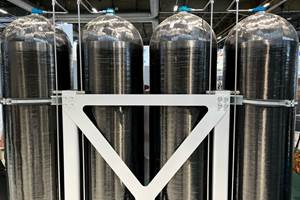Evonik study researches best resins for surface quality and shrinkage control
New white paper authored by Eike Langkabel, Sebastian de Nardo, and Jens Bockhoff, examines the best resin formulations for composites used in automotive part production, both structural parts and body panels.
A new white paper from Evonik Resource Efficiency GmbH (Marl, Germany), authored by Eike Langkabel, Sebastian de Nardo, and Jens Bockhoff, examines the best resin formulations for composites used in automotive part production, both structural parts and body panels. Specifically, the report takes a deep dive into the behaviour of various curatives and their effects on resin shrinkage, and compares epoxy and polyurethane formulations.
Residual stress is a significant problem in composites processing, say the authors, caused by chemical shrinkage of the matrix due to crosslinking of molecules, mismatch of thermal expansion or contraction among fibers and matrix (a cause of fiber print-through) and viscoelastic relaxation during fabrication. These phenomena are strongly coupled, and can lead to defects in the finished part like shape distortion, micro cracking, delamination, reduced mechanical strength, aging and wavy surfaces. And, for automotive composites, resin systems face conflicting demands: fast cycle times, which can produce residual stress, and Class-A surface quality, which decreases with increasing stress.
First, the researchers cured samples of various epoxies, using a bisphenol A diglycidyl ether (DGEBA) cured with isophorone diamine. Using a variety of test methods, including volume diatometry, DIN EN ISO 3521 (Pyknometer/Buoyancy Scale) and the pVT method (developed by RWTH Aachen University), the overall shrinkage behavior of the epoxy was determined to be 2.3-2.4%. Then, using thermomechanical analysis (TMA), changes in length were measured in epoxy samples, with the results indicating that the changes in dimension (shrinkage/expansion) are due to relaxation processes and the release of “frozen-in” free volume within the samples.
More tests were run using a range of reactive amines, the curing agents used in epoxy processing. Samples were created with cycloaliphatic, araliphatic and aliphatic amines, to determine their effects on shrinkage, and a variety of reactive diluents were also investigated, with the samples cured for 30 minutes at 120°C. The cycloaliphatic structures showed the lowest shrinkage (2.4%), while aliphatic structures show higher shrinkage. The longer the aliphatic chain length, the higher the shrinkage. And, the longer the aliphatic chain length (higher mobility) of the reactive thinners, the more shrinkage was observed, up to 4.5%.
The final part of the study was to produce composite parts using the resin transfer molding (RTM) process, to actually observe shrinkage and resultant part surface quality. All parts were made with the same fiber architecture, a quasi-isotropic layup using non-crimp fabrics, and were cured for 10 minutes at 120°C. The results verified that an epoxy resin formulation containing cycloaliphatic structures was superior over highly formulated resin systems that contain open chain aliphatic components, and produced a part with very little surface waviness, particularly when the part was made with an additional in-mold-coating (IMC) using the same resin formulation.
To further reduce shrinkage effects, say the authors, there is another approach: polyurethane prepreg. Evonik’s polyurethane system, which is based on aliphatic diisocyanate with a uretdione structure, cures quickly while still offering good mechanical properties and high toughness, and is stable with room-temperature storage. Because it behaves like a thermoplastic before cure, in its prepolymer state, it can be easily preformed, yet after cure it has thermoset properties. In terms of shrinkage, the paper compares epoxy cured with cycloaliphatic amine (IPD/DGEBA system, 2.4% shrinkage) to Evonik’s new resin, which exhibited less than 1% shrinkage, attributed to the chemistry and process differences.
The authors showed that using polyurethane prepreg in a simple PCM (Prepreg Compression Molding) process yields parts with surface qualities in the same range as the optimized epoxy formulations, while noting that surface properties in general are also linked to the fabrication process, the fiber architecture and the integrated surface finishing technologies (i.e., IMC) used.
Read the entire technical paper here.Related Content
Plant tour: Joby Aviation, Marina, Calif., U.S.
As the advanced air mobility market begins to take shape, market leader Joby Aviation works to industrialize composites manufacturing for its first-generation, composites-intensive, all-electric air taxi.
Read MoreRecycling hydrogen tanks to produce automotive structural components
Voith Composites and partners develop recycling solutions for hydrogen storage tanks and manufacturing methods to produce automotive parts from the recycled materials.
Read MoreCryo-compressed hydrogen, the best solution for storage and refueling stations?
Cryomotive’s CRYOGAS solution claims the highest storage density, lowest refueling cost and widest operating range without H2 losses while using one-fifth the carbon fiber required in compressed gas tanks.
Read MoreCo-molding SMC with braided glass fiber demonstrates truck bed potential
Prepreg co-molding compound by IDI Composites International and A&P Technology enables new geometries and levels of strength and resiliency for automotive, mobility.
Read MoreRead Next
VIDEO: High-volume processing for fiberglass components
Cannon Ergos, a company specializing in high-ton presses and equipment for composites fabrication and plastics processing, displayed automotive and industrial components at CAMX 2024.
Read MoreDeveloping bonded composite repair for ships, offshore units
Bureau Veritas and industry partners issue guidelines and pave the way for certification via StrengthBond Offshore project.
Read MorePlant tour: Daher Shap’in TechCenter and composites production plant, Saint-Aignan-de-Grandlieu, France
Co-located R&D and production advance OOA thermosets, thermoplastics, welding, recycling and digital technologies for faster processing and certification of lighter, more sustainable composites.
Read More















.jpg;maxWidth=300;quality=90)










